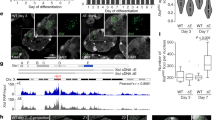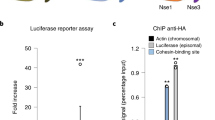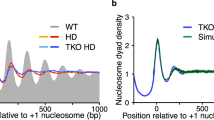Abstract
Transcriptional silencing in Saccharomyces cerevisiae at the HM mating-type loci and telomeres occurs through the formation of a heterochromatin-like structure. HM silencing is regulated by cis-acting elements, termed silencers, and by trans-acting factors that bind to the silencers. These factors attract the four SIR (silent information regulator) proteins, three of which (SIR2–4) spread from the silencers to alter chromatin, hence silencing nearby genes1,2,3,4. We show here that an HMR locus with a defective silencer can be silenced by anchoring the locus to the nuclear periphery. This was accomplished by fusing integral membrane proteins to the GAL4 DNA-binding domain and overproducing the hybrid proteins, causing them to accumulate in the endoplasmic reticulum and the nuclear membrane. We expressed the hybrid proteins in a strain carrying an HMR silencer with GAL4-binding sites (UASG) replacing silencer elements, causing the silencer to become anchored to the nuclear periphery and leading to silencing of a nearby reporter gene. This silencing required the hybrids of the GAL4 DNA-binding domain with membrane proteins, the UASG sites and the SIR proteins. Our results indicate that perinuclear localization helps to establish transcriptionally silent chromatin.
This is a preview of subscription content, access via your institution
Access options
Subscribe to this journal
Receive 51 print issues and online access
$199.00 per year
only $3.90 per issue
Buy this article
- Purchase on Springer Link
- Instant access to full article PDF
Prices may be subject to local taxes which are calculated during checkout




Similar content being viewed by others
References
Hecht, A., Laroche, T., Strahl-Bolsinger, S., Gasser, S. M. & Grunstein, M. Histone H3 and H4 N-termini interact with the silent information regulators Sir3 and Sir4: A model for the formation of heterochromatin in yeast. Cell 80, 583–592 (1995).
Triolo, T. & Sternglanz, R. Role of interactions between the origin recognition complex and SIR1 in transcriptional silencing. Nature 381, 251–253 (1996).
Hecht, A., Strahl-Bolsinger, S. & Grunstein, M. Spreading of transcriptional repression by SIR3 from telomeric heterochromatin. Nature 383, 92–96 (1996).
Strahl-Bolsinger, S., Hecht, A., Luo, K. & Grunstein, M. SIR2 and SIR4 interactions in core and extended telomeric heterochromatin in yeast. Genes Dev. 11, 83–93 (1997).
Gotta, M. et al. The clustering of telomeres and colocalization with Rap1, Sir3, and Sir4 proteins in wild-type Saccharomyces cerevisiae. J. Cell Biol. 134, 1349–1363 (1996).
Hiraoka, Y., Agard, D. A. & Sedat, J. W. Temporal and spatial coordination of chromosome movement, spindle formation, and nuclear envelope breakdown during prometaphase in Drosophila melanogaster embryos. J. Cell. Biol. 11, 2815–2828 (1990).
Funabiki, H., Hagan, I., Usawa, S. & Yanagida, M. Cell cycle dependent specific positioning and clustering of centromeres and telomeres in fission yeast. J. Cell Biol. 121, 961–976 (1993).
Marshall, W. F., Dernburg, A. F., Harmon, B., Agard, D. A. & Sedat, J. W. Specific interactions of chromatin with the nuclear envelope: Positional determination within the nucleus in Drosophila melanogaster. Mol. Biol. Cell 7, 825–842 (1996).
Brand, A. H., Breeden, L., Abraham, J., Sternglanz, R. & Nasmyth, K. Characterization of a “silencer” in yeast: A DNA sequence with properties opposite to those of a transcriptional enhancer. Cell 41, 41–48 (1985).
Chien, C.-T., Buck, S., Sternglanz, R. & Shore, D. Targeting of SIR1 protein establishes transcriptional silencing at HM loci and telomeres in yeast. Cell 75, 531–541 (1993).
Buck, S. W. & Shore, D. Action of a RAP1 carboxy-terminal silencing domain reveals an underlying competition between HMR and telomeres in yeast. Genes Dev. 9, 370–384 (1995).
Marcand, S., Buck, S. W., Moretti, P., Gilson, E. & Shore, D. Silencing of genes at nontelomeric sites in yeast is controlled by sequestration of silencing factors at telomeres by Rap1 protein. Genes Dev. 10, 1297–1309 (1996).
Munro, S. Sequences within and adjacent to the transmembrane segment of the α-2,6-sialyltransferase specify Golgi retention. EMBO J. 10, 3577–3588 (1991).
Machamer, C. E. et al. Retention of a cis Golgi protein requires polar residues on one face of a predicted α-helix in the transmembrane domain. Mol. Biol. Cell 4, 695–704 (1993).
Dean, N. & Poster, J. Molecular and phenotypic analysis of the S. cerevisiae MNN10 gene identifies a family of related glycosyltransferases. Glycobiology 6, 73–81 (1996).
Zufferey, R. et al. STT3, a highly conserved protein required for yeast oligosaccharyl transferase activity in vivo. EMBO J. 14, 4949–4960 (1995).
Karaoglu, D., Kelleher, D. J. & Gilmore, R. The highly conserved Stt3 protein is a subunit of the yeast oligosaccharyltransferase and forms a subcomplex with Ost3p and Ost4p. J. Biol. Chem. 272, 32513–32520 (1997).
Khosravi-Far, R. et al. Isoprenoid modifcation of rab proteins terminating in CC or CXC motifs. Proc. Natl Acad. Sci. USA 88, 6264–6268 (1991).
Kinsella, B. T. & Maltese, W. A. rab GTP-binding proteins with three different carboxyl-terminal cysteine motifs are modified in vivo by 20-carbon isoprenoids. J. Biol. Chem. 267, 3940–3945 (1992).
Maillet, L. et al. Evidence for silencing compartments within the yeast nucleus: a role for telomere proximity and Sir protein concentration in silencer-mediated repression. Genes Dev. 10, 1796–1811 (1996).
Stone, E. M., Swanson, M. J., Romeo, A. M., Hicks, J. B. & Sternglanz, R. The SIR1 gene of Saccharomyces cerevisiae and its role as an extragenic suppressor of several mating-defective mutants. Mol. Cell. Biol. 11, 2253–2262 (1991).
Renauld, H. et al. Silent domains are assembled continuously from the telomere and are defined by promoter distance and strength, and SIR3 dosage. Genes Dev. 7, 1133–1145 (1993).
Ma, J. & Ptashne, M. Anew class of yeast transcriptional activators. Cell 51, 113–119 (1987).
Pringle, J. R., Adams, A. E. M., Drubin, G. & Haarer, B. K. Guide to yeast genetics and molecular biology. Meth. Enzymol. 194, 565–602 (1991).
Harlow, E. & Lane, D. Antibodies: A Laboratory Manual (CSHL Press, Cold Spring Harbor, NY, (1988)).
Kaiser, C. A. & Schekman, R. Distinct sets of SEC genes govern transport vesicle formation and fusion early in the secretory pathway. Cell 61, 723–733 (1990).
Acknowledgements
We thank D. Gallwitz for communicating unpublished results; N. Dean, H. Park, S. Marcand, D. Shore and R. Brazas for plasmids and strains; and N. Dean, A. Mook and C. Dingwall for advice and comments. This work was supported by a grant from the NIH.
Author information
Authors and Affiliations
Corresponding author
Supplementary Information
Rights and permissions
About this article
Cite this article
Andrulis, E., Neiman, A., Zappulla, D. et al. Perinuclear localization of chromatin facilitates transcriptional silencing. Nature 394, 592–595 (1998). https://doi.org/10.1038/29100
Received:
Accepted:
Issue Date:
DOI: https://doi.org/10.1038/29100
This article is cited by
-
The regional sequestration of heterochromatin structural proteins is critical to form and maintain silent chromatin
Epigenetics & Chromatin (2022)
-
Spreading-dependent or independent Sir2-mediated gene silencing in budding yeast
Genes & Genomics (2022)
-
Engineering three-dimensional genome folding
Nature Genetics (2021)
-
Engineering 3D genome organization
Nature Reviews Genetics (2021)
-
Nucleolar release of rDNA repeats for repair involves SUMO-mediated untethering by the Cdc48/p97 segregase
Nature Communications (2021)
Comments
By submitting a comment you agree to abide by our Terms and Community Guidelines. If you find something abusive or that does not comply with our terms or guidelines please flag it as inappropriate.



